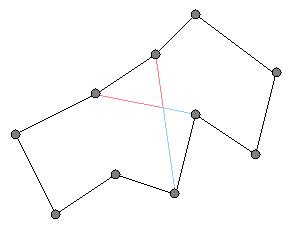- The simulation is started with the menus at the top of the window;
choose
Data,New,TSP. - A simulation for about 50 cities is just fine.
- The
runcommand is in one of the menus.
Continue.
Unfortunately, there is no graphic that gives a picture of
the path itself: just the path lengths are shown.
The results are more interesting if you choose:
strategy: p+cThe best parents plus children are selected for the next generation.- there are more than one
parents - more
childrenthanparents
There is also a version at Regensburg (a city about 150km South-East of Erlangen).


Fitting Data to a Straight Line
This is a short programming exercise which illustrates the minimization of a function for the purpose of fitting a curve. Consider the following data points (the numerical values are given below):We would like find the line y=a+bx which minimizes the chi-square best fit function.
- Print out a copy of the above graph and try to make a best fit estimate by "eyeball" using a ruler and a pencil. Record your values you obtain for a and b using this procedure.
- Read the Section "Fitting Data to a Straight Line" in Chapter 15 of your text. For simplicity we will assume that the errors associated with the y values are all equal to 1.
- Now, close your textbook and derive the formulas for a and b in terms of the data points.
- Write a simple program (there is no need to use subroutines here)
to calculate a and b.
- In C, the data points are:
#define NPOINTS 20 /* This is the number of data points*/ /* Here is a vector containing the x-values */ float x[NPOINTS]={0.0516082, 0.128727, 0.183212, 0.210909, 0.290406, 0.294732, 0.321201, 0.344, 0.363073, 0.43772, 0.500713, 0.50225, 0.565908, 0.571533, 0.72712, 0.770354, 0.835032, 0.845504, 0.850564, 0.964372}; /* Here is a vector containing the y-values */ float y[NPOINTS]={2.89574, 3.12705, 3.05028, 3.03999, 2.86911, 3.21711, 2.91052, 2.58598, 2.68829, 2.63369, 2.71827, 2.79343, 2.69613, 2.75923, 2.10584, 2.2825, 1.99966, 2.33427, 2.3399, 2.17499}; - In FORTRAN, we can use
DATAstatements to define the points:INTEGER NPOINTS PARAMETER (NPOINTS=20) REAL X(NPOINTS), Y(NPOINTS) C Here is a vector containing the x-values DATA X/0.0516082, 0.128727, 0.183212, 0.210909, 0.290406, & 0.294732, 0.321201, 0.344, 0.363073, 0.43772, 0.500713, & 0.50225, 0.565908, 0.571533, 0.72712, 0.770354, 0.835032, & 0.845504, 0.850564, 0.964372/ C Here is a vector containing the y-values DATA Y/2.89574, 3.12705, 3.05028, 3.03999, 2.86911, 3.21711, & 2.91052, 2.58598, 2.68829, 2.63369, 2.71827, 2.79343, 2.69613, & 2.75923, 2.10584, 2.2825, 1.99966, 2.33427, 2.3399, 2.17499/TheDATAstatements must come after all of the declarations and before any of the executable statements in a program. - Hint: use "copy" and "paste" to get the above lines into your program.
- As always, your code should be well commented. In this case it is particularly useful to define the important variables.
- In C, the data points are:
- Compare the results of your computer program with the results you obtained by "eyeballing" the graph.